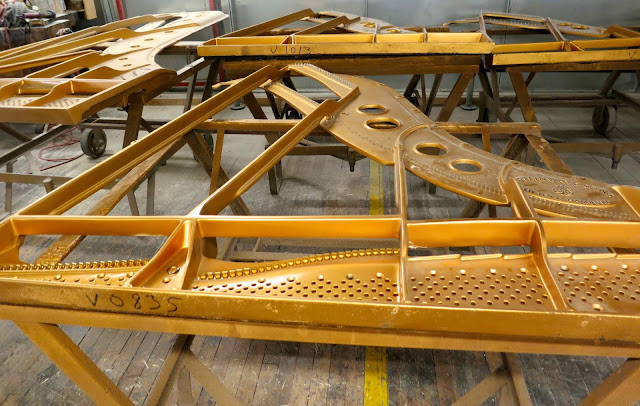Last week's serendipitous meeting of Phillip Kawin at Carnegie Deli began a wonderful close encounter with Steinway Piano that concluded today with the once-a-year factory tour in Queens. I walked to Steinway Hall on 57th Street where I joined several other folks on a van that took us to the Steinway and Sons Factory in Astoria. We initially met outside under a large white tent where we signed in, signed a waiver, and were issued protected goggles (not a good look for any of us). Then we were given a brief talk about how Steinway and Sons began in 1853 in Manhattan by German immigrant Henry Engelhard Steinway. A few years later they moved the factory to the "country" out in Queens where it stands today and where they continue to make these instruments by hand (with the help of a few smart machines).
Steinway Hall on West 57th Street
A Steinway was provided under the big tent for anyone to play. Need I say that I DID NOT play it (although I wanted to...in the privacy of my own home! )
Here's where it all begins...the year-long construction of a Steinway... with the wood being delivered to the factory. Steinway selects from only the top 1% of wood and then it goes through a serious process of culling only the best of the best, and even after that, places on the lumber that are not satisfactory are removed.
Beginning with the sound board
The machine in the background is so highly regulated, it can measure and cut the wood with the exactness of the size of a human hair. The workman uses the device in his right hand to make sure the pieces have been cut exactly to the standards.
The sign on this giant elevator says "This Is Not a Passenger Elevator." However, they got special permission to take us in it.
Steinway is very proud that their rims are one piece of wood. Men, not machines, actually move these into shape. The dude who talked to us about how it's done had massive arms.
It might be hard to tell what these are because of the negative space in the photo, but
these are piano legs!
Getting ready to be strung
A whole lot of plates waiting for bellies
We were told they have been getting more orders lately for plates painted silver instead of gold. They are both made out of the same metal...just painted different colors.
The soundboard, strings and plate
I can't even remember what this is.
One key has over 50 parts
The pianos go through several tunings, beginning with the first before the keys are even a part of the piano! At this point in the process, the technician has to pluck the strings. When it gets closer to the end of the process, the pianos are pulled into rooms where the technicians can hear better in order to get the over-all tone right. Much of the finer end of the tuning is done at the Steinway Hall.
This was one of my favorite parts of the tour. While we were standing around looking at the big boxes for shipping and the pianos waiting for new homes, someone in our group pointed out the end of one of the boxes. The markings indicated it was a piano intended for Lang-Lang. I don't know if that box was intentionally put there where we might see it, but no matter, it gave me a thrill!
Here I stand beside the little one I picked out.
Now, how do I get it home? (Just kidding T Lee! No I'm not. Yes I am.)
Just wish my buddies JO and LH had been with me!






























































